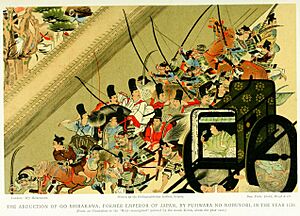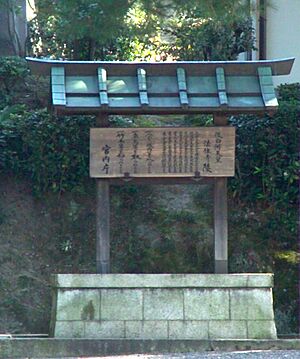Emperor Go-Shirakawa facts for kids
Quick facts for kids Emperor Go-Shirakawa後白河天皇 |
|||||
|---|---|---|---|---|---|
 |
|||||
| Emperor of Japan | |||||
| Reign | August 23, 1155 – September 5, 1158 | ||||
| Coronation | November 22, 1155 | ||||
| Predecessor | Konoe | ||||
| Successor | Nijō | ||||
| Born | October 18, 1127 | ||||
| Died | April 26, 1192 (aged 64) Rokujō-den (六条殿), Heian-kyō |
||||
| Burial | Hōjū-ji no Misasagi (Kyoto) | ||||
| Spouse |
Fujiwara no Kinshi
(m. 1155) |
||||
| Issue more... |
|
||||
|
|||||
| House | Yamato | ||||
| Father | Emperor Toba | ||||
| Mother | Fujiwara no Tamako | ||||
Emperor Go-Shirakawa (後白河天皇, Go-Shirakawa-tennō, October 18, 1127 – April 26, 1192) was the 77th emperor of Japan. He ruled officially from 1155 to 1158. However, he kept a lot of power for almost 37 years. He did this through a system called insei, where a retired emperor still guides the country.
Go-Shirakawa was very good at politics. He managed to have more influence than most emperors during his time. He was named after an earlier emperor, Emperor Shirakawa. The word Go- (後) means "later." So, he is sometimes called the "Later Emperor Shirakawa."
His time as emperor is known by two different era names: Kyūju (1154–1156) and Hōgen (1156–1159).
He was the last true emperor before the shogun took control of Japan. The shogun was the actual ruler of the country from Go-Shirakawa's death in 1192 until 1868.
Contents
Becoming Emperor of Japan
How Go-Shirakawa Took the Throne
On August 22, 1155, Emperor Konoe died when he was only 17. He had no children to take his place. This led to a big argument over who would be the next emperor.
The main choices were Prince Shigehito and Prince Morihito. Prince Shigehito was the son of the retired Emperor Sutoku. Prince Morihito was the son of Prince Masahito, who would later become Emperor Go-Shirakawa.
Many important people at court did not want Sutoku to gain power again. So, they supported Prince Masahito. He was 29 years old. The plan was for him to become emperor to make sure his son, Morihito, would get the throne later. This was unusual because Morihito was not made Crown Prince first. Prince Masahito became the new emperor, later known as Go-Shirakawa.
This decision made the retired Emperor Sutoku very angry. He had already been forced to give up the throne to Konoe before.
The Hōgen Rebellion
In 1156, the former Emperor Toba died. Soon after, the Hōgen Rebellion started. Sutoku tried to take the throne back from Go-Shirakawa. He gathered an army.
But Go-Shirakawa got help from two powerful warrior families: the Taira and the Minamoto. Their leaders were Taira no Kiyomori and Minamoto no Yoshitomo. Together, they easily defeated Sutoku's army. This left Go-Shirakawa as the only ruler.
This event changed Japanese politics forever. The emperor's family lost much of its power. The warrior clans, especially the Taira and Minamoto, became very important.
Go-Shirakawa's Rule and Challenges
Working with Kiyomori
In 1158, Go-Shirakawa stepped down from the throne. His son, Nijō, became the new emperor. But Go-Shirakawa became a "cloistered emperor." This meant he still held a lot of power behind the scenes. He kept this role through the reigns of five emperors until he died in 1192.
Go-Shirakawa was first an ally of Taira no Kiyomori. Kiyomori was the leader of the Taira clan. He helped Go-Shirakawa with money and military support.
In 1160, the Taira and Minamoto clans fought in the Heiji Rebellion. The Minamoto lost, and the Taira became the most powerful clan. Kiyomori's power grew very strong.
Kiyomori's Growing Power
As Kiyomori became more powerful, his good relationship with Go-Shirakawa ended. Kiyomori started to act like a dictator. He showed disrespect to the imperial family and other important families.
In 1169, Emperor Go-Shirakawa became a Buddhist priest. He was 42 years old. He felt he could no longer control Kiyomori. He took the Buddhist name Gyōshin.
Go-Shirakawa even supported a secret plan to overthrow Kiyomori. This plan was called the Shishigatani incident. But the plan was discovered. Everyone involved was punished, and Go-Shirakawa was put under house arrest.
Go-Shirakawa also helped Kiyomori gain more power without meaning to. In 1168, he removed his son Rokujō from the throne. He then made Takakura emperor. Takakura was related to Kiyomori's family. This gave Kiyomori a stronger link to the imperial family.
The Genpei War Begins
Go-Shirakawa wanted to get his power back. He decided to work with the Minamoto clan, the old rivals of the Taira. The Minamoto had been slowly getting stronger in the countryside.
In May 1180, Minamoto no Yorimasa called his clan to arms. He did this in the name of Prince Mochihito, who Yorimasa wanted to be the next emperor. Kiyomori found out and put Go-Shirakawa under even stricter watch. He also tried to arrest Mochihito. This started the Genpei War.
This rebellion was defeated, but it was just the beginning. Many more battles followed, which eventually led to the Taira clan's downfall.
The Minamoto Victory
The Minamoto clan won the long and difficult war. Go-Shirakawa helped them throughout the conflict. He had been in contact with Minamoto no Yoritomo since Kiyomori's death in 1181.
In 1183, the army of Minamoto no Yoshinaka entered the capital city. This allowed Go-Shirakawa to return to the city. He had been traveling to different shrines with armed monks to avoid being captured by the Taira.
Go-Shirakawa then ordered Yoshinaka to destroy the Taira clan. The emperor gave Yoshinaka the special title of Asahi Shōgun.
Go-Shirakawa also tricked the Taira. In 1184, he promised them a truce if they returned the Imperial Regalia and the emperor. This made the Taira unprepared for a surprise attack by Minamoto no Noriyori and Minamoto no Yoshitsune. This attack was the Battle of Ichi-no-Tani, a major turning point in the war.
There were also power struggles within the Minamoto clan. When Yoritomo got Go-Shirakawa's support, Yoshinaka attacked the cloistered emperor and burned his palace.
Finally, in 1185, Yoshitsune completely destroyed the Taira clan in a naval battle called the Battle of Dan-no-ura.
Go-Shirakawa's Final Years
Even after the war, Yoritomo and Go-Shirakawa had some disagreements. But they made up after Yoshitsune's death. Go-Shirakawa allowed Yoritomo to form a shogunate. The emperor's approval was needed for someone to become Shogun.
Go-Shirakawa died in 1192 at the age of 66. He was the father of two emperors: Nijō (the 78th emperor) and Takakura (the 80th emperor). He was also the grandfather of three emperors: Rokujō (79th), Antoku (81st), and Go-Toba (82nd).
His official burial place is Hōjū-ji no Misasagi in Kyoto.
Go-Shirakawa's Personality and Interests
People often described Go-Shirakawa as clever and sometimes tricky. He was also known for changing his mind often and following popular trends.
He loved literature and religion. He was a big fan of imayo poetry, especially poems about Buddhist themes. He spent a lot of money fixing and expanding temples and shrines. For example, he rebuilt the Todai-ji temple after the Taira clan burned it down in 1180.
He was also said to encourage the warrior monks from large temples to become even more powerful.
Family of Emperor Go-Shirakawa
Before he became emperor, his personal name was Masahito-shinnō. He was the fourth son of Emperor Toba. His mother was Fujiwara no Tamako.
He had many consorts and children, including:
- His first son, Imperial Prince Morihito, who later became Emperor Nijō.
- His empress, Fujiwara Kinshi.
- Another important consort, Taira no Shigeko, who was the mother of Imperial Prince Norihito, who later became Emperor Takakura.
- His third son, Prince Mochihito, who was involved in starting the Genpei War.
See also
 In Spanish: Go-Shirakawa Tennō para niños
In Spanish: Go-Shirakawa Tennō para niños




